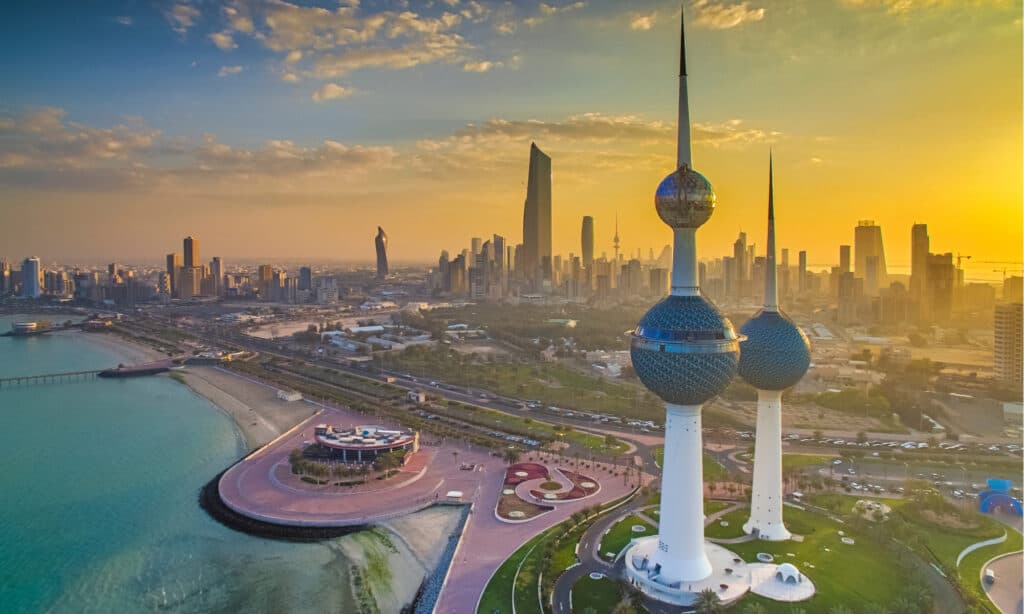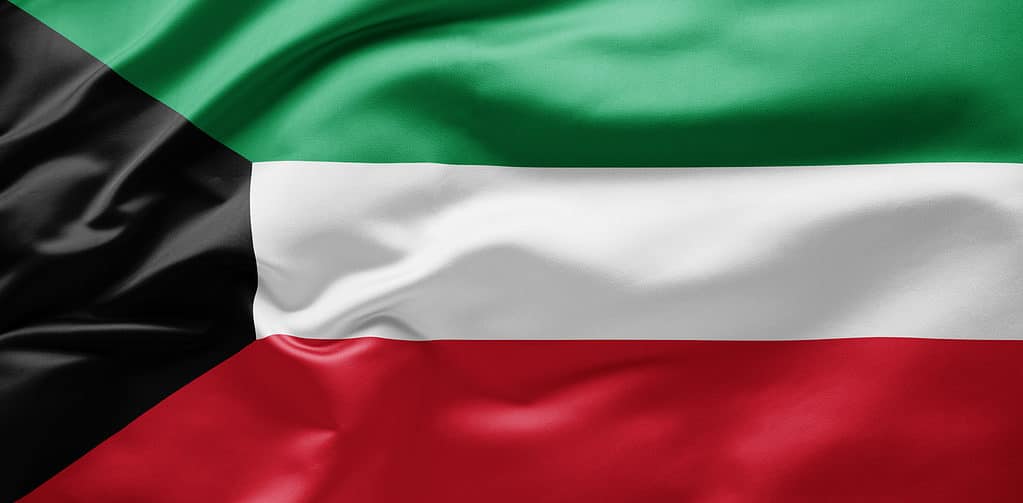Kuwait is a small emirate in the Middle East which shares borders with Saudi Arabia and Iraq. It is also a part of the Arabian Peninsula and borders the northwestern part of the Arabian Gulf, also known as the Persian Gulf. Although it shares a maritime border with Iran, the country is located in one of the driest deserts in the world.
The country has a land mass of 17,818 km² (6,880 square miles), making it a bit smaller than New Jersey. As of 2022, Kuwait had about 4.5 million inhabitants, although only one-third of these people are citizens—others are foreigners and expatriates. While English is Kuwait’s lingua franca, Arabic remains its spoken language. Its official religion is Islam.
One fascinating thing about this small but mighty country is that it’s a family-run empire. How did that happen? You’ll find the answers below, including other details surrounding the country’s flag.
The Founding of Kuwait

Kuwait gained independence in 1961.
©Anson Fernandez Dionisio/Shutterstock.com
Kuwait city was founded in the 17th century, and at that time, many of its inhabitants specialized in naval trade between Arabia and India. Due to this, Kuwait grew into a major commercial center in the northern Persian/Arabian Gulf and even became a primary port for Mesopotamia and the Arabian Peninsula. At some point, the region was under the rulership of Bani Khalid until Al Sabah arrived in 1716 and took over the reins of leadership.
Between the 17th and 18th centuries, Kuwait tried to remain free from the claws of colonial powers. Unfortunately, with the Ottoman Empire’s expansion towards the south, it was only a matter of time before Kuwait was annexed and transformed into a vassal state of the Ottoman Empire.
In 1896, Sheikh Mubarak Al-Sabah killed his two brothers and established himself as Kuwait’s ruler. Afterward, he contacted the British Empire to request protection. On the 23rd of November, 1899, Sheikh finally got the British Empire on his side, secretly signing a treaty where he agreed not to release any Kuwait land to external forces in exchange for British protection against foreign powers.
This treaty gave way to other treaties signed between the British government and Kuwait. Although these treaties helped to strengthen the relationship between both parties, they limited Al-Sabah’s authority. For instance, the ruling family couldn’t use oil resources and trade pearls without the consent of the British government.
The first Municipal Council was established in 1903, which consisted of 11 Kuwaitis and a leader from the Al Sabah dynasty. Afterward, there were other elections for several posts, like directorates for Health and Education, which increased awareness and made more Kuwaitis interested in overseeing their own affairs. The move for independence started in 1938 with the discovery of oil in the emirate. As Kuwait began exporting oil, it reaped high returns, and it soon became clear that the country was ready for independence.
Finally, on the 19th of June, 1961, Kuwait gained total independence from Britain, and the country became a member of the United Nations in 1963. However, this wasn’t the end of Kuwait’s problems as its independence was threatened by the Iraq invasion on the 2nd of August, 1990. Iraq invaded the emirate because Kuwait’s refusal to reduce oil production was affecting Iraq’s economy. Due to this, many Kuwaitis fled to seek refuge in other countries. After weeks of aerial attacks, Kuwait was liberated by a military campaign led by the United States on the 23rd of February, 1991.
Al-Sabah family has always ruled Kuwait, and Sheikh Mubarak Al-Sabah is regarded as the actual founder of the country. Kuwait’s present constitution recognizes the Al-Sabah family as the ruling family.
History of the Flag of Kuwait

Kuwait finally adopted its current flag on the 24th of October, 1961.
©iStock.com/Oleksii Liskonih
During the reign of the Ottoman Empire, Kuwait’s flag had a red field with a crescent and star. Following the agreement between Kuwait and the British in 1899, Kuwait flew a similar red flag with a crescent moon and a five-pointed star. This time, however, there was an Arabic inscription on the flag. In 1909, the moon and star were enlarged, and the Arabic text was moved to the top right corner of the flag. Then in 1915, the moon and star were taken off the flag, the Arabic text was moved to the center, and a broad white stripe was included on the left side.
In 1921, under the British protectorate, Kuwait was declared an independent sheikhdom, spurring the people to change their flag again. Still retaining the red field, it had the Arabic inscription and the Shahada lettering, which meant, “There is no god but God; Muhammad is the messenger of God.” This flag was used until 1940, when the Sabah family logo was added. This current design remained in use until 1956, when a new flag with a red field and a white wavy stripe on the left side was adopted. It also had the Shahada lettering.
This remained the country’s flag until it gained independence in 1961. Kuwait finally adopted a Pan-Arab-colored flag on the 24th of October, 1961. It consists of green, white, and red horizontal stripes with a black trapezoid on the hoist side.
The Symbolism of the Flag of Kuwait

The black trapezoid at the hoist side of Kuwait’s flag represents Kuwait’s victory over its rivals.
©iStock.com/Zerbor
The green stripe on Kuwait’s flag represents the country’s beautiful fertile land and plantations. The white signifies peace which the country desires, and the red stripe represents the blood shed by Kuwaitis during the struggle for independence from the British Empire. The black trapezoid at the hoist side represents Kuwait’s victory over its rivals.
Up Next:
- Animals in Kuwait
- The Flag of Iraq: History, Meaning, and Symbolism
- The Flag of Canada: History, Meaning, and Symbolism
The photo featured at the top of this post is © iStock.com/RM80
Thank you for reading! Have some feedback for us? Contact the AZ Animals editorial team.







